Emeodilichi H. Mba
Department of Geography, Nasarawa State University, Keffi, Nigeria
Correspondence to: Emeodilichi H. Mba, Department of Geography, Nasarawa State University, Keffi, Nigeria.
| Email: |  |
Copyright © 2018 The Author(s). Published by Scientific & Academic Publishing.
This work is licensed under the Creative Commons Attribution International License (CC BY).
http://creativecommons.org/licenses/by/4.0/

Abstract
Charcoal is mostly pure carbon known as char that is been produced by cooking of woods in low oxygen environment which takes some days and burns some volatile compounds like water, methane, hydrogen and tar, but when been produced in commercial quantities this burning takes place in large hole, concrete, bricks and steel silos with little oxygen’s and its been stopped halfway to avoid over burning that will turn it to ash. It contains black lumps and powder with about 25% of the original weight. This charcoals is been produced for commercial and domestic purposes like cooking and industrial uses. Production processes starts with cutting down of trees, cutting them into trunk parts and transporting it to the charcoal production site for the burning process that takes days and excess tree cutting without reforestation program causes deforestation which contributes to carbon dioxide accumulation in the atmosphere, for trees absolves carbon dioxide CO2 and gives out oxygen and when there is excess carbon as a result of human and other factors with less trees to absolve them, more carbon dioxide will be trapped in the atmosphere causes warming that can forces climate change which creates extreme weather conditions like drought, melting of ice, excess rainfalls and others. This study recommends that proper awareness, monitoring should be implemented on all charcoal production sites and government should improve on some few basic amenities to substitute usage of charcoals like electricity and gas, with a proper afforestation program to protect these depleted forests reserves.
Keywords:
Charcoal, Global warming, Carbon dioxide
Cite this paper: Emeodilichi H. Mba, Assessment of Charcoal Production Processes and the Environment Impact in Kaduna, Nigeria, Resources and Environment, Vol. 8 No. 5, 2018, pp. 223-231. doi: 10.5923/j.re.20180805.02.
1. Introduction
Charcoal is the lightweight black carbon and ash residue hydrocarbon produced by removing water and other volatile constituents from animal and vegetation substance especially trees. According to report, historically the production of wood charcoal dates back to a very ancient period since about 4000 BC in both China and West Asia, North and South American, Africans and Europeans also made used of charcoal. The way people made charcoal was generally by piling wood up and covering it with dampened dirt and lighting the wood on fire, so that it burned very slowly without much oxygen. The best charcoal comes from burning hard woods which generally consists of piling billets of wood on their ends so as to form a conical pile, openings being left at the bottom to air intake, with a central shaft to serve as a flue then the whole pile is covered with turf or moistened clay, but this process varies from one place to another, firing start from the bottom of flue, gradually spreads outwards and upwards and success of this process depends upon the combustion rate. Under average conditions, 100 parts of wood yield about 55 parts by volume or 20 parts by weight of charcoal while small-scale production on the spot often yields less than 50% and large-scale became efficient to yield above 80% Charcoal production site is located where there is abundance of woods like forest reserve areas which are the main source of the production. The operation is delicate and tedious that the charcoal burners live inside the site or very close to the site for monitoring activities of the burning progress. This production process is not quite different from once predominantly practiced in Nigeria, which consist of 5 production stages.1. Tree cutting 2. Making of holes3. Gathering of grasses/dirt4. Arrangement of the tree trunks5. Burning and opening process1. Tree cutting: This is the first stage in charcoal production which involves cutting down of tree, cutting them into trunk size and allowing them to dry for sometimes for wet trunks cannot not burn. According to charcoal producers different trees produces difference type of charcoal, some trees species produces what is called iron charcoal; consumers that use in small quantity find this type of charcoal difficult to use because it starts with slow pace in burning and burns fast if eventually starts burning, but for people that use it in large quantity like restaurants it’s the must prefer type because of it’s lasting capacity, also it is more expensive, while some trees species produces what they call soft charcoal; this type of charcoal is the best for those users that requires it in small quantity like households because the burning process starts easy and burns at normal pace but it don’t last like the former which makes it more cheaper. This tree cutting stage is not suppose to involve all tree size, predominantly big tree sizes, but because of high demand of charcoal and lack of afforestation in the forest the charcoal producers has results in cutting down small and medium size trees to meet their costumers demand and to sustain the business, this has resulted to the serious depletion of forest reserves within all this charcoal production ground and areas..Table 1. Tree names and species
 |
| |
|
2. Making of hole: This second stage involves making of ground hole to accommodate the number of woods per each production and creation of space for covering, the hole size measured in foot (ft), 5ft depth and 4ft width depending on the quantity of the production, each ground holes accommodates minimum of fifteen big trunks of woods and maximum of twenty small trunks of wood. This stage is easier during the raining season to dry season because it’s easy to dig during raining season than dry season.3. Gathering of grass: This stage comes in when they are done with the two previous stages, this involves gathering of grasses, dirt and tree leafs that are being used in covering woods trunks after arranging to prevent much oxygen before closing it with sand at the top most. This stage also damages other vegetation like grass, tree leaf and the diet that serves as manure for cultivation purposes and also creates conflict of interest because grasses that some people suppose to use in feeding there animals or herbs are been used for this processes and during raining season grasses will be had to find and the little ones left will be damaged on the process and if not found they will result in cutting the small tree leafs in other to make up. This stage is easier during raining season and difficult during the dry season.4. Arrangement of tree trunks: This is the stage where those dried wood trunks will be arrange into the ground holes accordingly, creating spaces between them that act as a smoke channel and also to check the burning process because if left unchecked it might over burn or stop burning without their notice, after this arrangement process then the woods will be covered with the grass, dirt or leaf already gathered and finally with sand with small space to make the fire by adding small kerosene that will still be covered up when the fire starts. There are different trunk and the sizes determines the number to be arranged per hole.Table 2. Hole size, Trunk size and Numbers
 |
| |
|
5. Burning and opening process: After all the four stages next is the burning process which is the stage five refer to stage 4 the fire will be applied through a small space created under the it with the application of small kerosene to start the fire, the burning will last between two to three days with close monitoring depending on type of wood used; Reason for the close monitoring is to prevent collapse incident that does happens if not well covered with fresh leaf and sand which can be prevented if it’s being monitored very well. The opening starts from the top with water to cool off the fire and this is another reason must site visited are being located close to streams and river for water accessibility.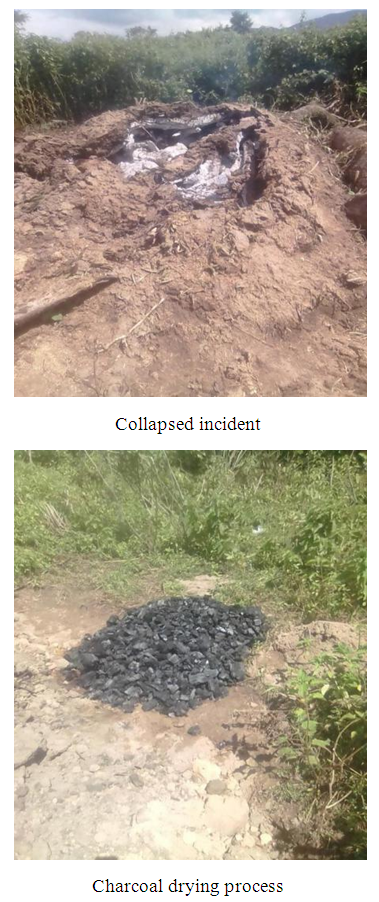 | Figure 1 |
After the cooling process the charcoal will now be gathered in an open area for it to dry up, this another difficult part during the raining season because some site don’t have enough shade to spray there product. Four big tree produces minimum of 10 to 15 of 100kg bags of charcoal while small trees produces 8 to 14 of same 100kg bag per hole which is maximum of 50 bags per week depending on covering, opening and monitoring process which are the must delicate part of the processes. 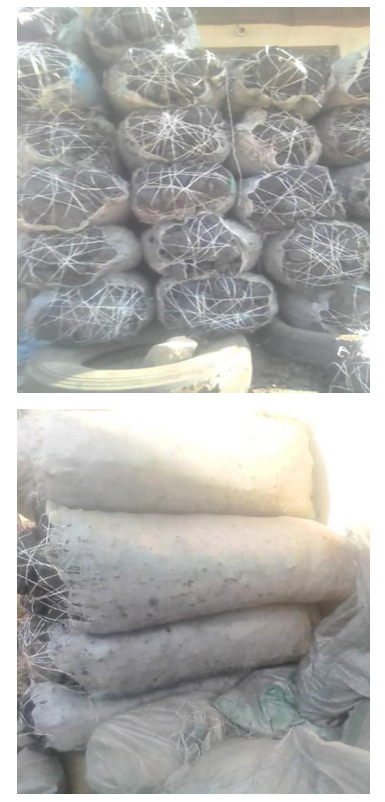 | Figure 2. Charcoals assembled for sale |
This are the five major processes predominantly practiced in Nigeria for this charcoals are been produced in rural villages were there is forest reserves. This charcoal being produced are used for different purposes like domestic activities, Industrial usage and for export, but in Nigeria its mostly used for domestic activities followed by export and minimal industrial use. Poverty is the major contributor to this domestic usage of charcoal due to lack of basic amenities like electricity, cooking gas and high cost of kerosene joined with dangers of adulterated kerosene that have caused fire outbreaks in many homes resulting to life and properties lost. Other factor that contributes to high usage of charcoal for domestic activities also is its advantage to produce less smoke emission because of its dryness which allows it to burn at a high temperature with carbon dioxide mainly the end product. This makes it easy for homes to keep their cooking material like pots clean and reduce smoke emission at homes.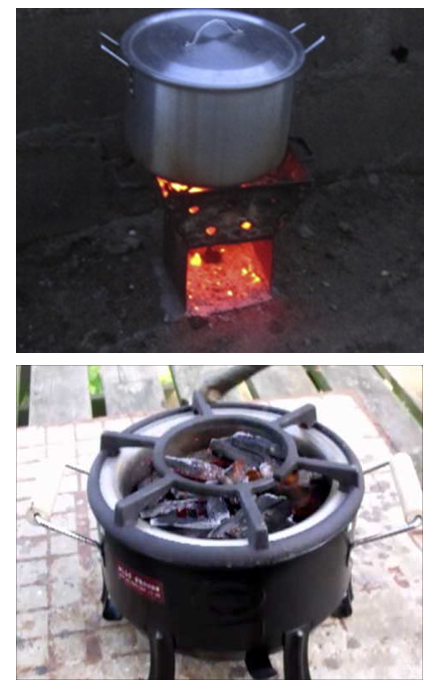 | Figure 3. Charcoal cooking equipment |
Charcoal production process contributes in various environmental problems like;i Deforestationii Green house gas emissioniii Soil Impactiv EcosystemDeforestation: Deforestation is clearing up of forest areas and converting them to other purposes like Agriculture, Urbanization and wood-fuel which includes charcoal production. This charcoal production contributes highly to deforestation for the main source of charcoal production is trees and to produce charcoal trees most be cut down. About 31% of the world land surface is covered by forest, while in Nigeria it falls gradually from 16.6% in 1996 to 7.7% in 2015, According to Food and Agricultural Organization of United Nation as of 2005 Nigeria has highest deforestation rate in the world at 12.2% equivalent of 11,089,000 hectares had been deforested and between (2000 to 2005). Michael Daley, associate professor of environmental science at Lasell College in Newton, Massachusetts, the number one major problem caused by deforestation is the impact on the global carbon cycle, when this trees are been cut down those carbon they supposed to absorb as food through photosynthesis process will be trapped in the atmosphere and this contributes to the increases on carbon dioxide accumulated in the atmosphere. Moreover there are more emission also created when felled trees releases the carbon they had been storing and rot or burn on the forest floor, so not only that this trees act as carbon dioxide mitigation but cutting them down also increases carbon dioxide emission through carbon cycle process. Forest makes up about 30% of total land cover and are of incredible value to life on earth, they are carbon bank and play very important role in climate control, climate mitigation and effects of global warming, also act as watershed and with many raw materials that human depends on joined with the bio-diversities it contains. Trees lowers temperature through transpiration of water and shading of surface and also reduces heat sink while carbon dioxide makes trees healthier which in turn serve as climate change mitigation which are major causes of global warming. Green house gas emission: This charcoal production process takes place in a poor oxygen environment which results in formation of incomplete combustion products like methane, also produces emission of green house gas such as carbon dioxide CO2 and Methane CH4 and with some elements of carbon monoxide but it is not record by (IPCC 2004) as green house gas. Emission from charcoal production in tropical region was estimated at 71.2million t for carbon and 1.3million t for methane in 2009.Table 3. Green House Gas Emission (%)
 |
| |
|
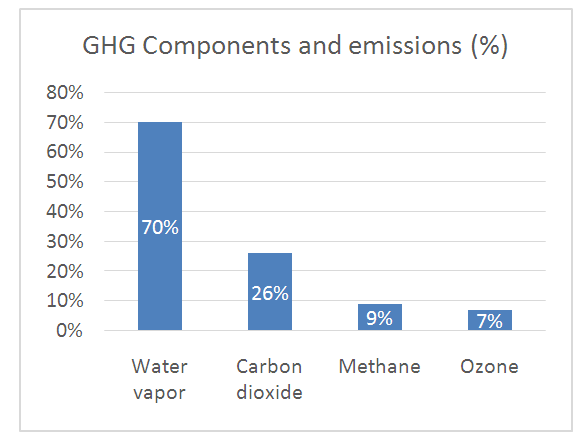 | Figure 4 |
From figure 4, Carbon dioxide emission comes second followed by methane in global warming contributors. According to work published in 2007, concentration of carbon dioxide CO2 and methane had increased by 36% and 48% since 1750 while fossil fuel burning from human activities produces about 3qtrs increase in carbon dioxide. Carbon dioxide reading in 2013 reached all time high surpassing 440ppm, highest since 4.5million years according to Prof P Hoskins. Also in march 2015, for the first time in million years carbon dioxide concentration exceeded 400ppm. According to NASA scientist on 12th, November 2015, reported of continuous increase of human made carbon dioxide above level not seen in hundred years and also that it is not been absorbed by vegetation and ocean which makes it to remain in the atmosphere causing climate change with global warming as the impact. All this should had been absorbed by tree if they are enough since it’s there own food. Carbon dioxide is gas that consist one part carbon and two part oxygen, it is very important gas on earth for plant uses it to produce carbohydrate in a process called photosynthesis and since humans and animals depends on plant for food, this photosynthesis is very important for life survival on earth. Photosynthesis is a process by which plants and some microbes create food, uses up carbon dioxide, this organisms combine carbon dioxide and water (H2O) to produce carbohydrates like sugars and emit oxygen as by-product, Forests and ocean areas that act as massive carbon sinks by removing carbon dioxide from the atmosphere and the rise in this process led to an increase in oxygen which is very important to humans and reduces the amount of carbon dioxide trapped in the atmosphere. Some amount of carbon dioxide occurs naturally in the atmosphere while other human activities contributes highly the increase and this carbon dioxide account for 77% of human greenhouse emissions because even basic human activities like breathing and food digest also produces this carbon dioxide and it is not safe when we produces carbon dioxide more than our flora can absorb. A gradual increase in CO2 concentrations in Earth's atmosphere helps to drive global warming, threatening to disrupt our planet's climate as average global temperatures gradually rise.According to report deforestation contributes 87% of carbon dioxide emissions in Nigeria and data collected between 2000 to 2005, shows that the country have lost 55.7% of it’s primary forest to deforestation which makes it the highest in the world. From the figure above it also shows that there was high rise on carbon dioxide emission between 1995 to 2005. All this high carbon dioxide emissions and methane emissions contributes to global warming that forces extreme weather condition like: Temperature rise, Drought and heatwaves, High rainfall, Rise on sea level, Melting of ice.Table 4. Nigeria Carbon emission 1960 - 2014
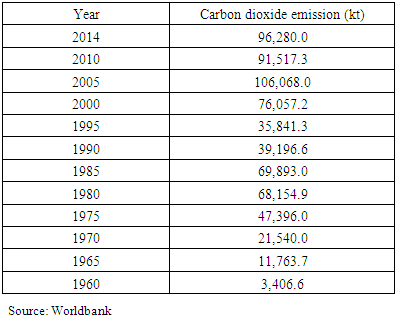 |
| |
|
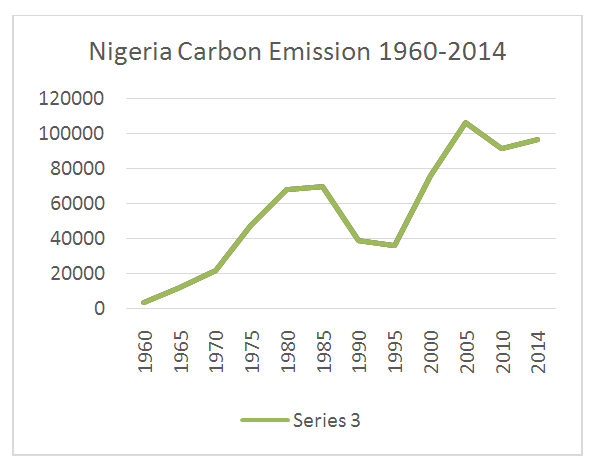 | Figure 5 |
Soil Impact: Charcoal production impact on the soil happens in two different stage, the impact on the production pit where the combustion or burning process takes place due to amount of heat generated as the result of the covering process and the second impact is within the surrounding of the production pit. But there is more impact on the first stage then the second. Some studies on the impact of charcoal production to soil like Ogundele A.T (2011) in Oyo, Nigeria observed that soil under charcoal production has a slight increase in PH compere with the control site which had not been subjected to charcoal production. This was as result of the ashes generated during this production process which contribute to the PH rise. Other studies like Oguntunde et al (2008) observed that soils under those charcoal hole had a reduced bulk intensity and surface albedo, higher porosity and soil surface temperature and higher infiltration rate than the adjacent field soils. The impact experienced within the surrounding of this site where the harvesting of this woods takes place is the similar to any low impact forest clearing that don’t result to land use change.Ecosystem: Impact on ecosystem comprises the deforestation impact like loss of bio-diversity and millions species of habitat's endangering of plants and animals also depletion forest reserves meant for the purpose of protecting environment which serves as shield from direct impact of downpour of rain, high temperature and wind that will result of erosion, flood and other environmental instability. About 80% of earth land animals and plants home is forest and charcoal production which contributes highly to deforestation in Nigeria has a grievous impacts to their home which is forest. Another impact on our ecosystem the green house gas release during the production process and the carbon dioxide in particular released from dead vegetation that decomposes in the ground as a result of tree cutting and other vegetation damage during this process. 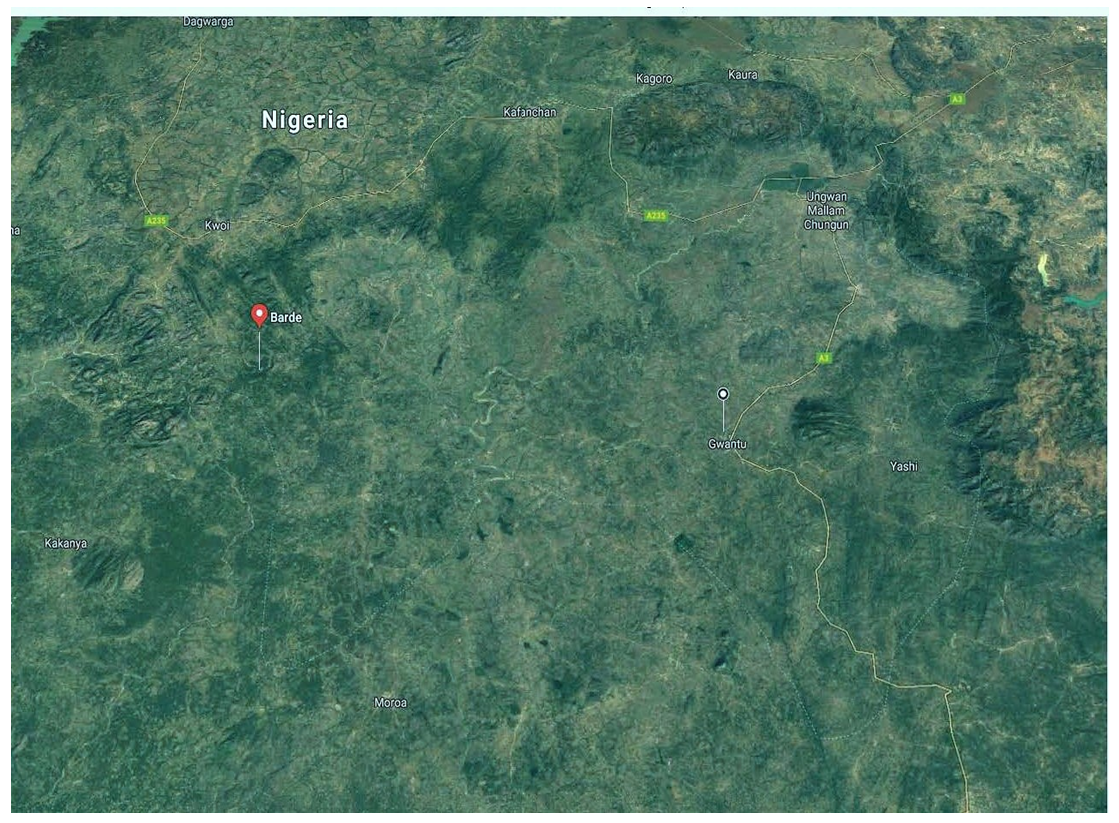 | Figure 6. Aerial view of Barde and Gwantu marked on the map |
2. Material and Methodology
The study was conducted in Kaduna state of Nigeria and located in the North-Central region of the country, Kaduna is bordered by the states of Zamfara, Katsina, and Kano to the north; Bauchi and Plateau to the east; Nasarawa to the south; and Niger to the west. Abuja Federal Capital Territory also borders Kaduna state to the southwest. They are among the highest producers of charcoal in the Northern part of Nigeria mostly down south of the state that houses many forest reserves. This charcoal production are the major thing depleting the forest in those areas and the more trees are being cut down the more accumulation of unused carbon dioxide in the atmosphere causing global warming and forcing climate change.This paper is based on primary and secondary source through interviews, discussion with charcoal producers in Kaduna South region with the permission of their chairman and information’s accessed through review of relevant texts, journals, newspapers, official publications, magazines and internet which served as tangible source of insight into the environmental impacts of charcoal production process.Data of production quantity and number of trees used was collected from charcoal producers in all the five locations.Table 5. Locations and Minimum Quantity production table
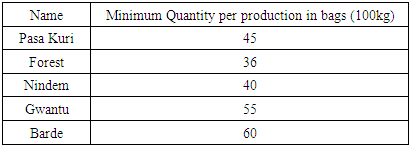 |
| |
|
 | Figure 7 |
This production site are all located within Southern Kaduna and a production quantity table was developed which shows the tree size, number of tree used and days required for production. An average number of tree and quantity of production for both big tree and small tree size was calculated. If a single big tree absorbs 481lb of carbon dioxide per year it means a single tree absorbs 1.4lb per day, this was used to determine amount of carbon dioxide that should had been absorbed by those trees cut down during this charcoal production process and was label (assume carbon dioxide loss). Different site visited produces high quantity of charcoal in that region but the production process details was collected from Barde and Gwantu because both generates the highest quantity of charcoal respectively due to their land mark and rich forest.Table 6. Production Table
 |
| |
|
To get the average number for both tree size, this formula was applied:(Avg = total sum of all the numbers/Number of item on the table)>Average numbers of tree: 4 + 6 = 10/2 Total average of tree numbers = 5 trees.>Average number of bags produced: 20 + 14 = 34/2Total average number of bags produced = 17 bags.
3. Results and Discussion
This five production locations covers the southern Kaduna area of Kaduna state with high quantity of production dated back over 30 years but have increased over the years due to high demand of the product, at the same time more trees are being cut down which contributes to an increase carbon dioxide that serves as tree food will be trapped in the atmosphere which also contributes to global warming the more it accumulates and not absorbed. More than 50% of the forest in Barde and Gwantu locations had been depleted because of this charcoal production process.99% of this charcoal producers disagreed that there business has any effect to the environment while 1% agreed but blames government inability to provide jobs, 90% also don’t believe in tree planting (Afforestation), their believe is that tree will never finish up in the forest, while 10% believed after some awareness in the process of this research.Due to high demand of charcoal and depletion going in this forest areas, charcoal producers have started moving beyond their territory in search of much bigger trees and they will transport them to the site for production process.60% of animals Barde are on extinction because of the impact of deforestation, in Gwantu Shea tree that is being used to produce iron charcoal is running out in there forest. Surrounding of this charcoal production site are no longer been used for Agriculture, according to the producers they believe it’s no longer good for cultivation.Table 7. Number of tree/Assume CO2 loss per production
 |
| |
|
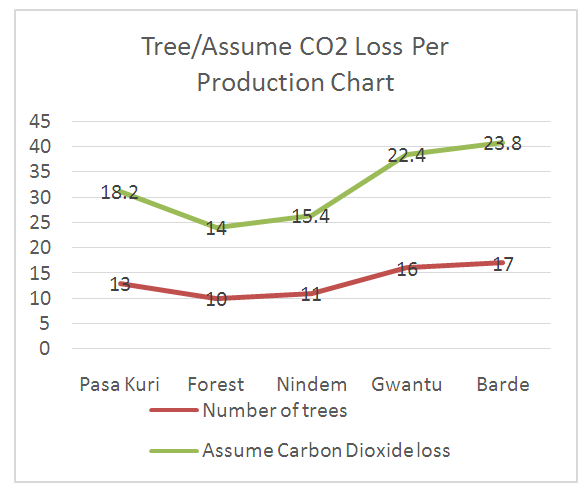 | Figure 8 |
From the figure 8 above, Barde has the highest number of production followed by Gwantu with high number of trees loss and assume carbon dioxide which supposed to have served as tree food through photosynthesis that contribute to more carbon dioxide being trapped in the atmosphere. Barde alone has the capacity to produce 480 bags of charcoal in a month, which requires average of 141 trees to be cut down for this process and if multiplied with quantity of carbon dioxide intake per tree (1.4lb) it will give 197.4lb of assume carbon dioxide loss in one production month for one site only. This goes to other four locations and all over the country where this charcoal production is taking place.From the table 7, an average of 67 trees are being lost per production from the five locations and 236 bags of charcoal produced.Factors contributing to the increase in charcoal production are:i Povertyii Lack of basic amenitiesiii Awareness iv Lack of policies and enforcementPoverty: High rate of poverty in the country contributes highly to this charcoal production, reason because 95% of the population depends on kerosene which is not cheap to get due to cost and fear of adulterated product that causes explosion in household, because of this many depends on charcoal which is cheap and also safe. With the high number of charcoal users, increases the production which endangers our forest reserves and more deforestation.Table 8. Nigeria population in poverty (1980 - 2010)
 |
| |
|
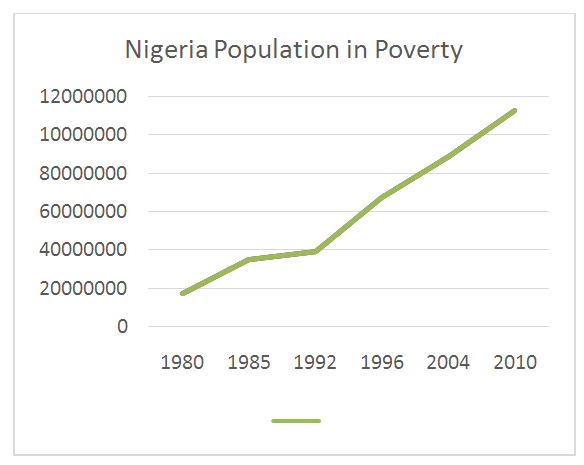 | Figure 9 |
Lack of basic Amenities: Government failure in provision of basic amenities like electricity, cooking gas and kerosene contributes to increase on charcoal usage, for people now depends solely on charcoal due to poor power supply and the cooking gas which the price kept on increasing beyond the middle class not even the lower class citizens, this results to many household switching to charcoal burners that are well constructed for household. According to the World Bank collection of development indicators Nigeria wood charcoal production quantity was reported at 4022763 tonnes in 2011, this are captured record because there are more that are not captured.Awareness: Most villages around this charcoal production site has no knowledge of impact of this charcoal production, of all the 5 locations visited none of them has knowledge of the impact of charcoal production to the environment, many blamed the government failure to provide jobs which made them to engage on this charcoal business. When asked about afforestation, none has knowledge of it too for they believe that trees will never finish and it will grow on there own before they finish the ones left behind by their ancestors. In all this areas there was nothing like forest guard or any non-governmental organization educating them why and how to plant trees.Kaduna state multiyear draft estimate 2017 under the Kaduna state environmental protection authority the budget for (conduct of formal and informal environmental awareness programs) had been on decline, no fund was allocated for the program back in 2016 but there was draft estimate and proposed estimate in 2017, 2018 and 2019 and this estimate is not a guaranty of fund.Table 9. Kaduna state Multilayer draft budget
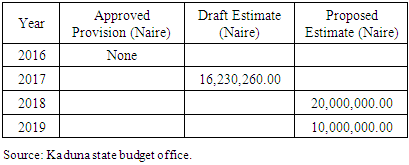 |
| |
|
Lack of Policies and Enforcement: According to the ministry of forestry, poor manpower contributes highly to this situation, inadequate funding which effects logistics for the rangers movement, as result of this no policies in place to regulate and monitor activities in our forest reserves that result in this people making use of the forest in cutting down trees without control, even the small tree is being cut down. Barde and Gwantu forest visited where all those charcoal production is been taking place, must of the mature big trees are gone and they have turned to small tree growing up.
4. Recommendations and Conclusions
Solution to challenges posed by charcoal production in Nigeria depends on policy and resilience, awareness, prudent forest management and getting involve the private sectors, combined with proactive actions and policies. Nigeria leaders current and future have all failed to address the infrastructural and basic amenities problems also prioritizing of educating the young generations’ dangers posed by this maniac going on in all the major forest reserves. The poor are most vulnerable to environmental hazards and owing to unequal distribution of assets in the country, will also suffer most from the effects generated by this charcoal production, increase in temperature, Flood and other forms of degradation effects. Increasing the opportunity on the basic amenities for the vulnerable is the only way to sustain overall growth and reduce disparity. Disparity on basic amenities like kerosene, cooking gas and electricity most be reduced drastically so the even if the laws is been enforced, poor people will have alternatives and see reason to keep to the rules and regulations.This charcoal producers should be engaged by creating an enabling environment, educating them the advantages of tree planting which will preserve their business and clearing that notion that trees will never finish because it will grow on there own while government should facilitate, support and make those basic amenities easy to access also leverage the strength of the stakeholders to create policies with significant outreach at maximum efficient with less burden on the public resources. Public sectors, NGO, global partnerships, research and academics communities should engage in discovering and educating the host communities the best species of trees and best way of planting them.Nigeria have good enabling environment for charcoal business but need to expend in scope, coverage, efficient to sufficiently safe the forest from total extinction. Government and citizens will benefit if there is a well-articulated forestry policies programs significantly that will reduce the amount of trees cut as a result of charcoal business through a robust afforestation program also improve in the supply of affordable basic amenities thereby making life unproblematic to the citizenry.
References
| [1] | Ogundele A. T., Eludoyin O. S. and Oladapo O. S. Assessment of impacts of charcoal production on soil properties in the derived savanna, Oyo state, Nigeria, Journal of Soil Science and Environmental Management Vol. 2(5), pp. 142-146, May 2011 ISSN 2141-2391 ©2011 Academic Journals. |
| [2] | Emmanuel N. Chidumayoa Davison J. Gumbob; The environmental impacts of charcoal production in tropical ecosystems of the world: A synthesis; doi.org/10.1016/j.esd.2012.07.004. |
| [3] | Emeodilichi H. Mba, Assessment of Environmental Impact of Deforestation in Enugu, Nigeria, Resources and Environment, Vol. 8 No. 4, 2018, pp. 207-215. doi: 10.5923/j.re.20180804.03. |
| [4] | AU - Onekon, Walter, AU - KOECH, Oscar; PY - 2016/12/01; SP - 327; EP - 335; T1 - Assessing the effect of charcoal production and use on the transition to a green economy in Kenya VL - 19 JO - Tropical and Subtropical Agroecosystems ER. |
| [5] | Impact of increased charcoal consumption forest and woodlands in Tanzania Dr. Felician Kilahama, President, Tanzania Association of Foresters, P.O. Box 426, Dar-es-Salaam. |
| [6] | "Nigeria Forest Information and Data". rainforests.mongabay.com. Retrieved 15 April 2018. |
| [7] | IPCC (2014). Climate Change 2014: Mitigation of Climate Change. Contribution of Working Group III to the Fifth Assessment Report of the Intergovernmental Panel on Climate Change [Edenhofer, O., R. Pichs-Madruga, Y. Sokona, E. Farahani, S. Kadner, K. Seyboth, A. Adler, I. Baum, S. Brunner, P. Eickemeier, B. Kriemann, J. Savolainen, S. Schlömer, C. von Stechow, T. Zwickel and J.C. Minx (eds.)]. Cambridge University Press, Cambridge, United Kingdom and New York, NY, USA. |
| [8] | Jump up^ Schmidt, G.A.; R. Ruedy; R.L. Miller; A.A. Lacis (2010), "The attribution of the present-day total greenhouse effect" (PDF), J. Geophys. Res., 115, Bibcode: 2010JGRD.. 11520106S, doi:10.1029/2010JD014287, archived from the original (PDF) on 22 October 2011, D20106. |
| [9] | Broecker, W. S. (1975). Climatic Change: Are We on the Brink of a Pronounced Global Warming? Science, 189(4201), 460–463. http://doi.org/10.1126/science.189.4201.460. |
| [10] | Climate Data Primer. Climate.gov. |
| [11] | Global Warming FAQ. Climate.gov. |
| [12] | Conserve-energy-future-facts. |
| [13] | How do we know the world has warmed? by J. J. Kennedy, P. W. Thorne, T. C. Peterson, R. A. Ruedy, P. A. Stott, D. E. Parker, S. A. Good, H. [11] A. Titchner, and K. M. Willett, 2010: [in "State of the Climate in 2009"]. Bull. Amer. Meteor. Soc., 91 (7), S79-106. |
| [14] | IPCC 2007, Summary for Policymakers, in Climate Change 2007: Impacts, Adaptation and Vulnerability. Contribution of Working Group II to the Fourth Assessment Report of the Intergovernmental Panel on Climate Change, Cambridge University Press, Cambridge, UK, p. 17. |
| [15] | National Academy of Sciences, Climate Research Board, Carbon Dioxide and Climate: A Scientific Assessment (Jules Charney, Chair). (1979). Washington, DC: National Academy of Sciences. [Online (pdf)] http://web.atmos.ucla.edu/~brianpm/download/charney_report.pdf. |












 Abstract
Abstract Reference
Reference Full-Text PDF
Full-Text PDF Full-text HTML
Full-text HTML







